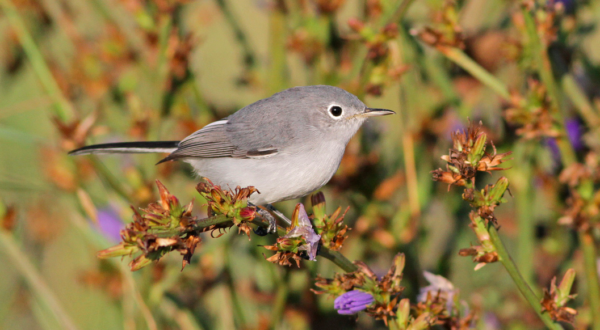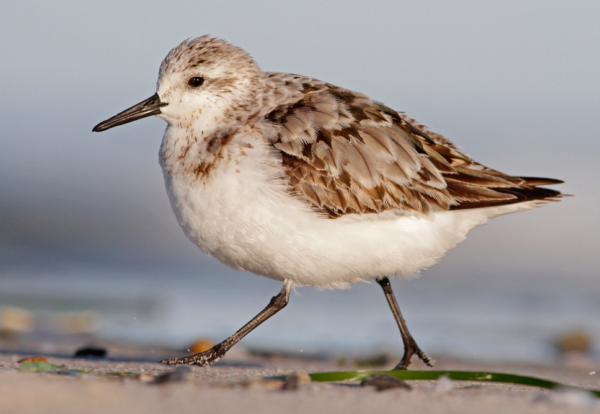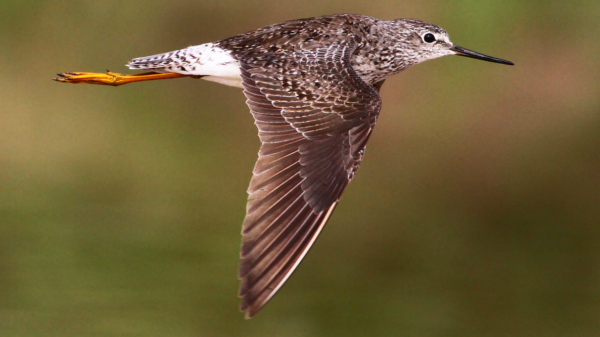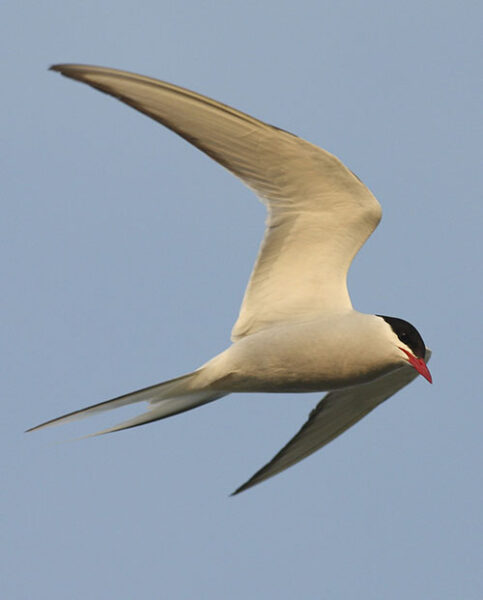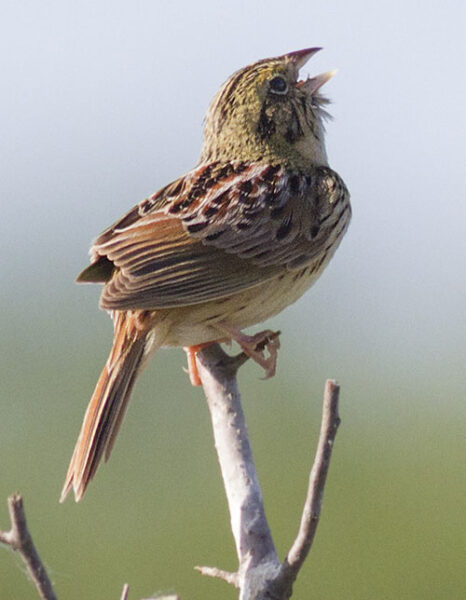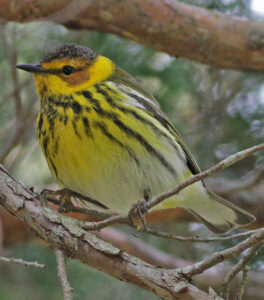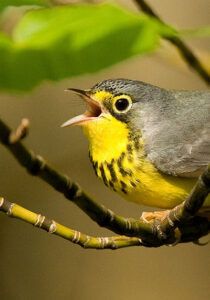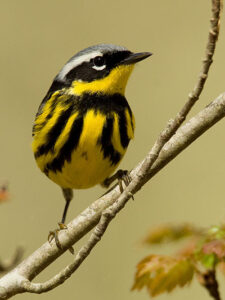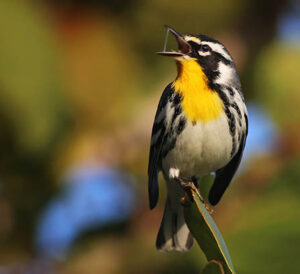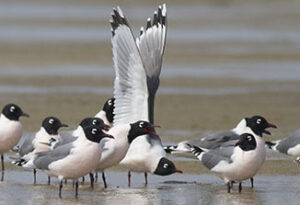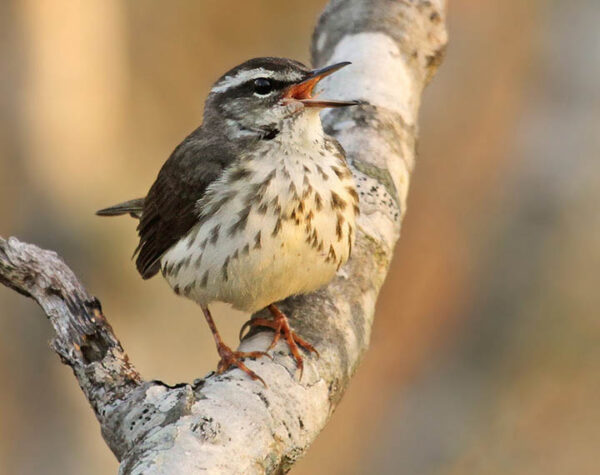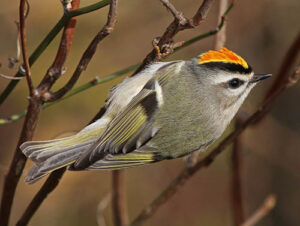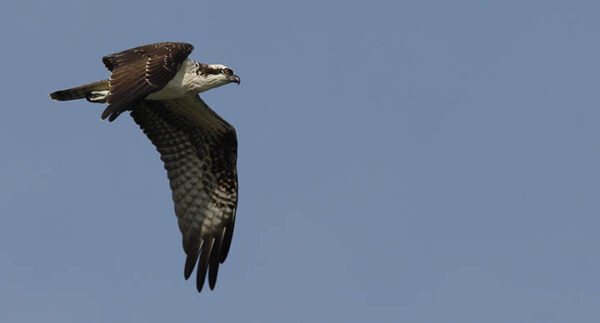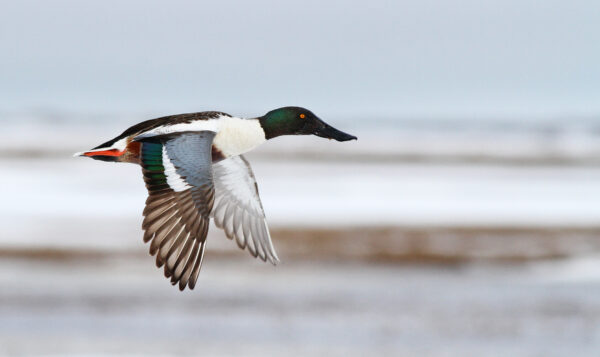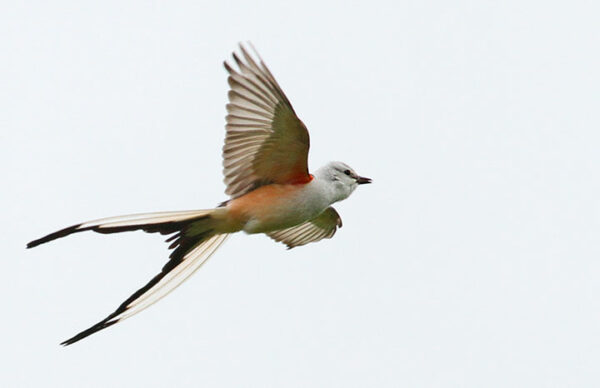News: Migration
A new article is available that describes BirdCast and its place in the world of what big data are teaching us about nocturnal bird migration. Please visit the article here. Read more...
Favorable conditions early in the period will bring moderate movements featuring Northern Pintail, Warbling Vireo, Swainson's Thrush, Wilson's Warbler, and Western Tanager in parts of the West, particularly the Pacific Northwest, while a passing cold front early in the week will bring moderate to locally heavy movements of Warbling Vireo, Red-eyed Vireo, Veery, Blue-gray Gnatcatcher, Ovenbird, Northern Waterthrush, Blackburnian Warbler, Chestnut-sided Warbler, and Rose-breasted Grosbeak in its wake before southerly flow slows down the system in the East. Read more...
Scattered light to moderate movements featuring American Wigeon, Sanderling, Yellow Warbler, Wilson's Warbler, and Yellow-headed Blackbird highlighted the week in the West, while Black-bellied Plover, Wilson's Phalarope, Common Nighthawk, Least Flycatcher, Chestnut-sided Warbler, Yellow Warbler, and Wilson's Warbler composed generally light early period and increasing moderate and even isolated heavy later period movements in the East. Read more...
A brief pulse of light to moderate flights that will include American Avocet, Marbled Godwit, Western Sandpiper, Western Kingbird, Barn Swallow, Black-headed Grosbeak, and Bullock's Oriole on either end of the forecast period highlight otherwise unfavorable conditions across the West, while a relatively weak front drifts east mid week bringing light to moderate flights of Osprey, Greater Yellowlegs, Semipalmated Sandpiper, Ruby-throated Hummingbird, Purple Martin, and Tree Swallow first to the northern Plains, then the Great Lakes, and finally the Appalachians and portions of the eastern seaboard. Read more...
All but the latest of migrants already passed, this week saw in the primarily scattered light and highly localized moderate movements across the West, with late migrants featuring Olive-sided Flycatcher, Willow Flycatcher, Cedar Waxwing, and Townsend's Warbler, while the East saw its light to moderate flights concentrated in the center of the country and featuring primarily departures of Least Sandpiper, White-rumped Sandpiper, Short-billed Dowitcher, Cedar Waxwing, Swainson's Thrush, Tennessee Warbler, Blackpoll Warbler. Read more...
As the spring migration winds down for most species, this forecast period sees early week light to moderate movements in the West that feature Common Nighthawk, White-throated Swift, Warbling Vireo, Cedar Waxwing, and Gray Catbird and mostly moderate flights in the East that feature late season shorebirds, Least Tern, Yell0w-billed Cuckoo, Acadian Flycatcher, Alder Flycatcher, and Cedar Waxwing among other late season passerine migrants. Read more...
This period brought light to moderate flights that featured Western Sandpiper, Dunlin, Long-billed Dowitcher, Swainson's Thrush, and Cedar Waxwing to the West, primarily in the middle of the week and scattered from California to the Rockies and north to Canada, while the East enjoyed moderate to locally heavy early and later week flights that featured Black Skimmer, Common Nighthawk, Black-billed Cuckoo, Yellow-billed Cuckoo, Swainson's Thrush, Cedar Waxwing, and Dickcissel. Read more...
With peaks of spring movements in the rear view for most species, this week will see scattered light flights across much of the West, with moderate flights along the eastern front of the Rockies, that will feature Black Tern, Cordilleran Flycatcher, Willow Flycatcher, MacGillivray's Warbler, and Blue Grosbeak, and moderate to heavy midweek flights where and when precipitation does not fall in the East, featuring Black-bellied Plover, Black Tern, Olive-sided Flycatcher, Alder Flycatcher, Yellow-bellied Flycatcher, and Mourning Warbler. Read more...
A reasonable quiet late migration season week in the West featured movements of Black Tern, Olive-sided Flycatcher, Swainson's Thrush, Gray Catbird, Northern Waterthrush, American Redstart, particularly in the Desert Southwest and northern Rockies, while moderate to heavy flights in the East early in the week, featuring White-rumped Sandpiper, Sanderling, Black Skimmer, Eastern Wood-Pewee, Marsh Wren, Saltmarsh Sparrow, and Orchard Oriole, subsided as a more early spring like air mass arrived. Read more...
Several widespread pulses of moderate to heavy flights featuring White-rumped Sandpiper, Stilt Sandpiper, Ruddy Turnstone, Common Nighthawk, Eastern Wood-Pewee, Alder Flycatcher, Blackpoll Warbler, and Mourning Warbler punctuated the week across the East, while mid week moderate to locally heavy flights along the eastern Rockies were highlights of the period's assemblage of Black Tern, Least Flycatcher, Dusky Flycatcher, Plumbeous Vireo, Swainson's Thrush, MacGillivray's Warbler, and Blue Grosbeak in the West. Read more...
Continental Summary Need a review of our definitions for regions, species on the move, and migration amounts? Please visit this link. Quick Links to Regions Upper Midwest and Northeast Gulf Coast and Southeast Great Plains West Upper Midwest and Northeast Top Movers Gulf Coast and Southeast Top Movers Great Plains Top Movers West Top Movers ––––––––––––––––––––––––––––––––––– Farnsworth and Van Doren Read more...
Favorable conditions for light to moderate flights begin and ends the period for the West as Black-bellied Plover, Lesser Yellowlegs, Willow Flycatcher, Swainson's Thrush, Townsend's Warbler, Virginia Warbler, and Blue Grosbeak are on the move, while the moderate to heavy flights that will include White-rumped Sandpiper, Short-billed Dowitcher, Least Flycatcher, Philadelphia Vireo, Blackpoll Warbler, Chestnut-sided Warbler, Wilson's Warbler, Rose-breasted Grosbeak, Savannah Sparrow and White-crowned Sparrow navigate around some serious weather in the first half of the period and quiet markedly with that weather's departure to end the period. Read more...
Widespread favorable conditions that bring light to moderate flights including Solitary Sandpiper, Western Wood-Pewee, Dusky-capped Flycatcher, Gray Flycatcher, Warbling Vireo, Orange-crowned Warbler, Yellow-breasted Chat, and Black-headed Grosbeak to the West early in the week become increasingly restricted to the Desert Southwest by the end of the week, while the arriving major pulse of southerly flow and warmer air toward the end of the weekend in the East brings moderate to heavy, and locally very heavy, flights for the rest of the period that will include Broad-winged Hawk, Least Sandpiper, Olive-sided Flycatcher, Veery, Wood Thrush, Wilson's Warbler, Mourning Warbler, Black-throated Blue Warbler, Lincoln's Sparrow, White-throated Sparrow, Rose-breasted Grosbeak. Read more...
Pulses of light to moderate movements will follow the favorable conditions across the West, particularly early in the week, and will feature Lesser Yellowlegs, Dunlin, Bonaparte's Gull, Caspian Tern, Vaux's Swift, Black-throated Gray Warbler, Wilson's Warbler, and Yellow-headed Blackbird, while the East sees moderate to heavy flights that track those favorable conditions early to mid week and that feature a large number of arrivals including Green Heron, Willet, Wilson's Snipe, Red-eyed Vireo, Cliff Swallow, Yellow-throated Warbler, Kentucky Warbler, and Swamp Sparrow among many others. Read more...
An active beginning and end to the forecast period in the West featured light to moderate movements primarily in the southern portion of the region and included Western Sandpiper, Franklin's Gull, Cassin's Vireo, Black-throated Gray Warbler, and Nashville Warbler, while increasingly widespread moderate movements punctuated the period in the East and included Franklin's Gull, Ruby-crowned Kinglet, Common Yellowthroat, Chipping Sparrow, and Summer Tanager. Read more...
Light to moderate movements featuring Green Heron, Osprey, Rufous Hummingbird, White-throated Swift, and Common Yellowthroat will be the norm from Friday through the middle of the coming work week in the West, as moderate to heavy flights come to many parts of the East and feature Ruddy Duck, Whimbrel, Northern Flicker, Tree Swallow, Golden-crowned Kinglet, Louisiana Waterthrush, and Indigo Bunting. Read more...
Light to moderate movements, primarily in California and the Desert Southwest, in the first half of the week included Swainson's Hawk, Franklin's Gull, Barn Swallow, Cliff Swallow, Nashville Warbler, Common Grackle for the West, while scattered pulses of light to moderate movements reached a peak by the end of the week in the East and included Great Crested Flycatcher, Tree Swallow, Golden-crowned Kinglet, Chipping Sparrow, Swamp Sparrow, and Orchard Oriole. Read more...
Friday and Monday nights will be the most extensive of the light to moderate movements that occur in the West this week featuring Cassin's Vireo, Tree Swallow, Orange-crowned Warbler, Common Yellowthroat, Black-throated Gray Warbler, White-crowned Sparrow, while several pulses of more extensive light to moderate movements grace the East from Saturday through Wednesday featuring Double-crested Cormorant, Osprey, Pectoral Sandpiper, Baird's Sandpiper, Eastern Phoebe, Yellow-throated Vireo, Hooded Warbler, and Fox Sparrow. Read more...
While the West saw early and late forecast period light to moderate movements along the Pacific Coast and in the Desert Southwest including Broad-tailed Hummingbird, Orange-crowned Warbler, Black-headed Grosbeak, and Bullock’s Oriole, scattered light to moderate movements peaking on Tuesday and Wednesday nights including Greater White-fronted Goose, Blue-winged Teal, Barn Swallow, Brown Thrasher, Lapland Longspur, Vesper Sparrow, and Chipping Sparrow increased in the East. Read more...
Most of the movement in the West this period occur this weekend and early in the week, with light to moderate movements that will see increasing arrivals of Osprey, Rufous Hummingbird, Bell's Vireo, and Hooded Oriole, while the East will experience the greatest intensity and extent of moderate movements from Monday through Thursday with increasing arrivals of Great Blue Heron, Great Egret, American Golden-Plover, Belted Kingfisher, Louisiana Waterthrush, and Song Sparrow. Read more...

